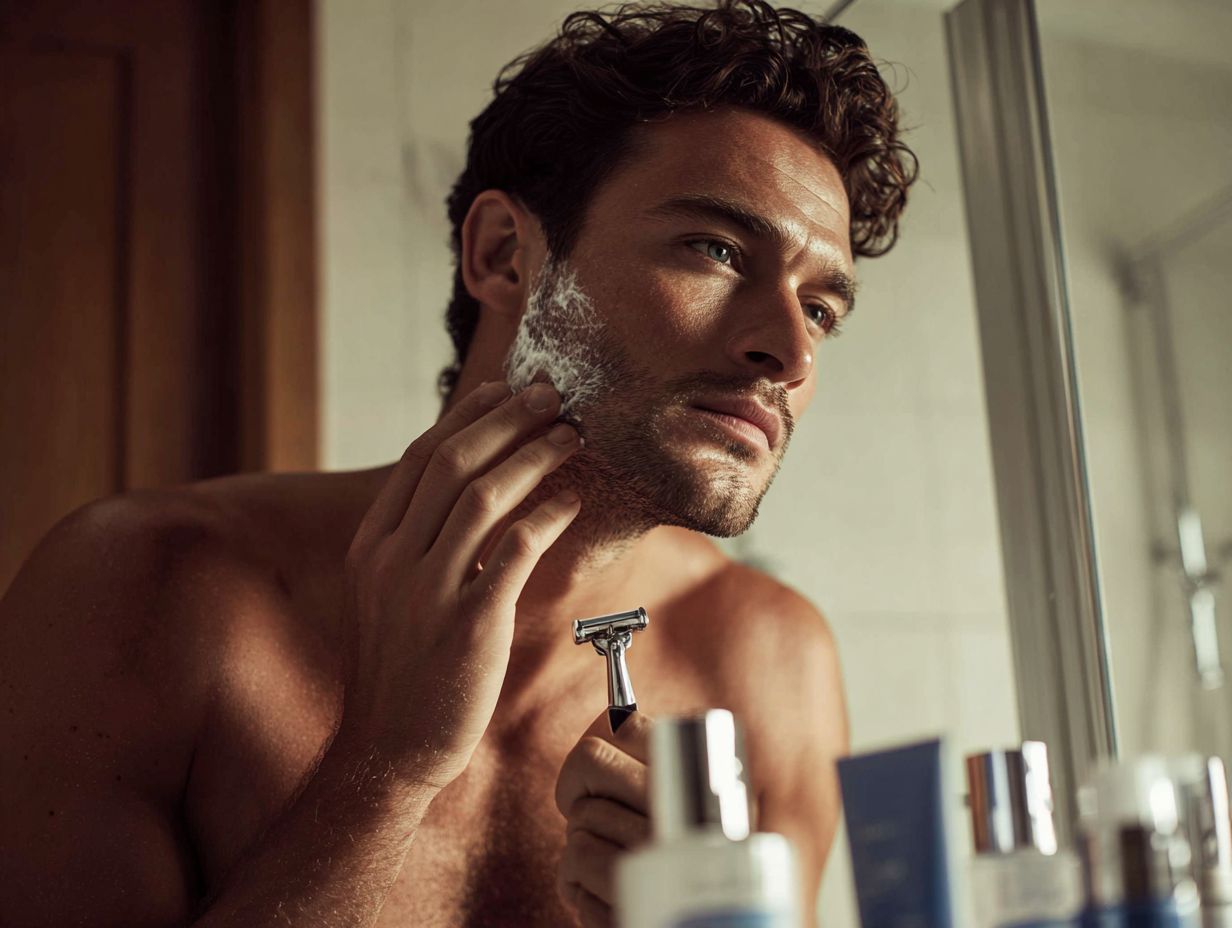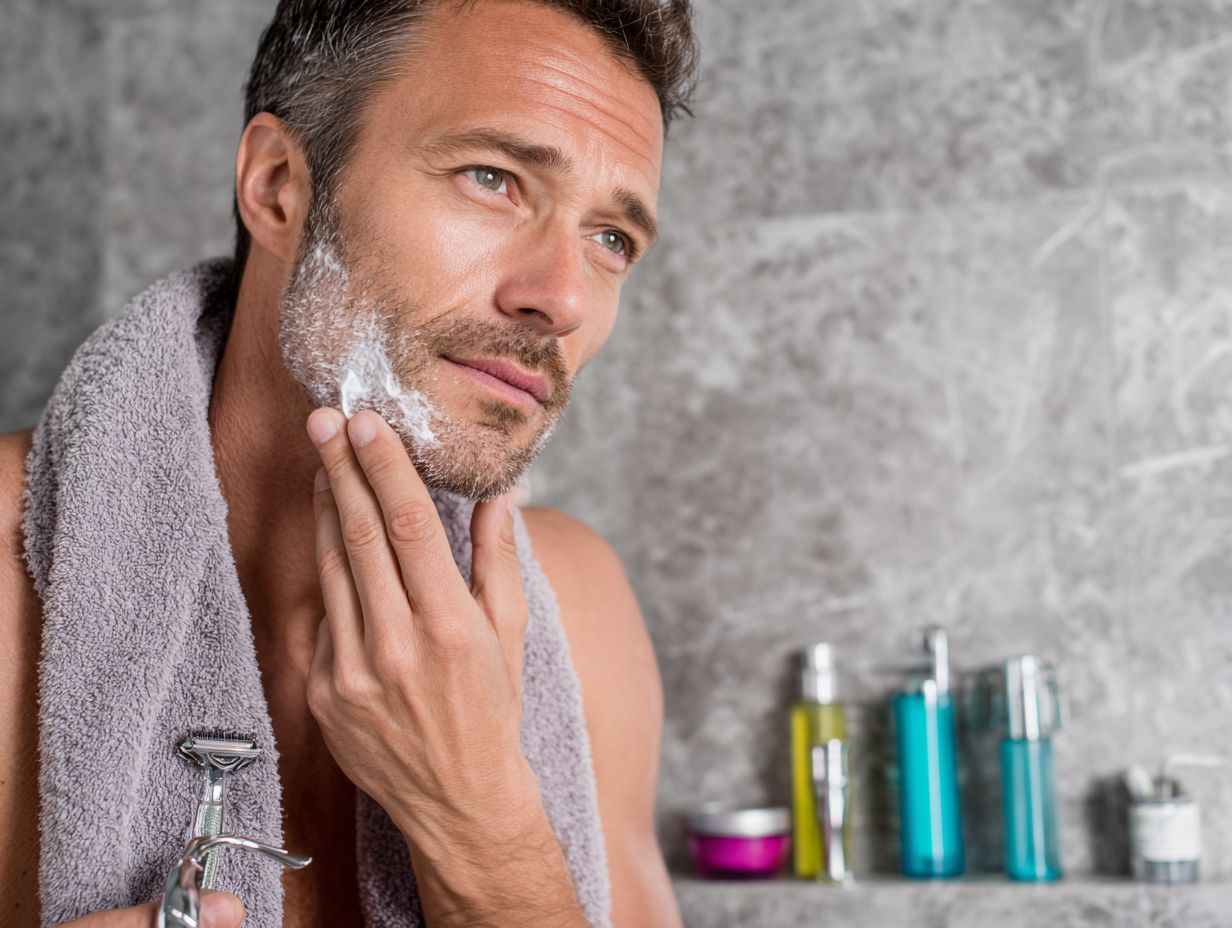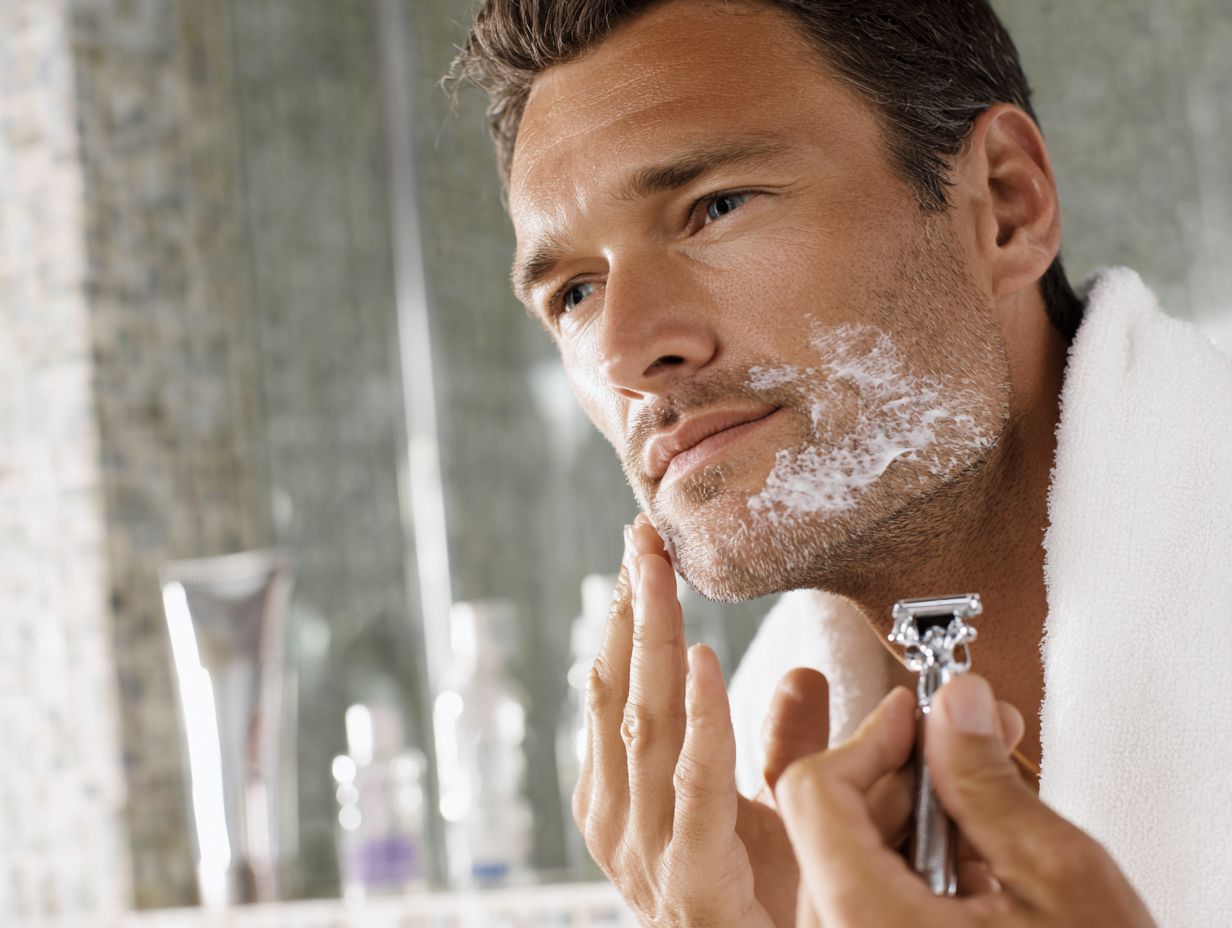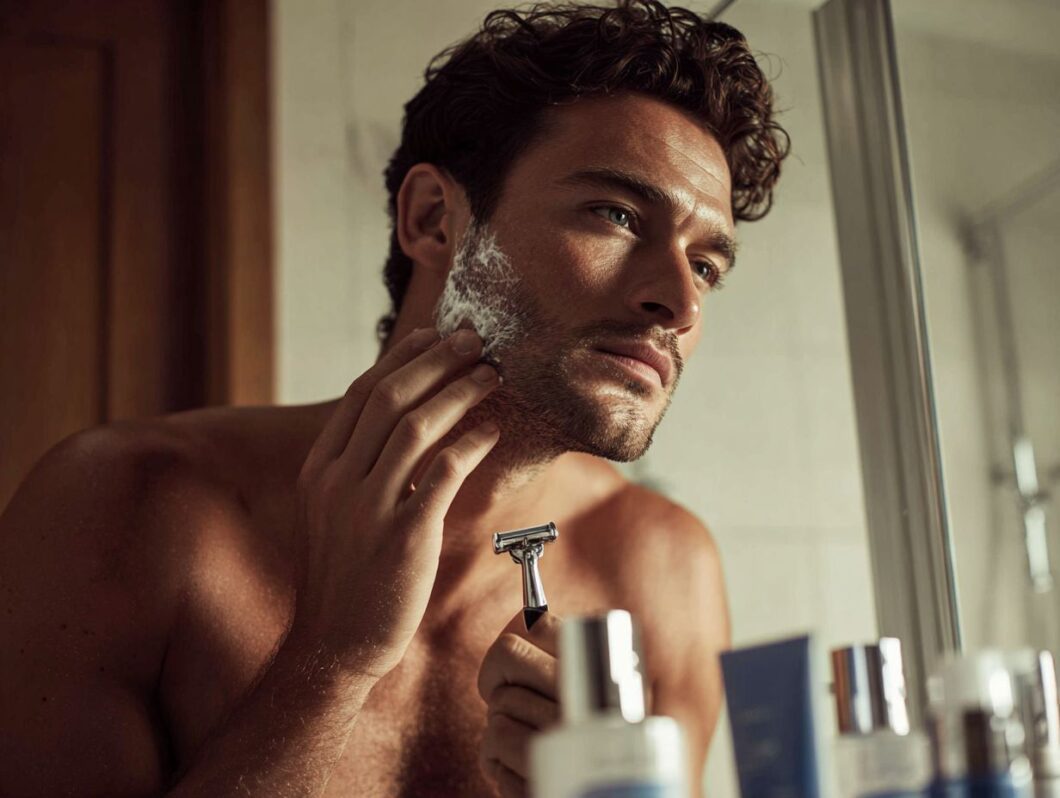Razor burn can turn your shaving routine into a painful experience, leading to skin irritation that’s hard to ignore. According to Dr. Shilpi Khetarpal from the Cleveland Clinic, the key to a smoother shave lies in proper preparation and technique. In this article, we’ll explore effective tips, from choosing the right shaving cream to the importance of exfoliating, to help you combat razor burn and achieve a comfortable, irritation-free shave.
Key Takeaways:
Understanding Razor Burn

Razor burn is a frequent skin irritation I experience after shaving, which often results in discomfort and the appearance of visible bumps on the skin.
What is Razor Burn?
Razor burn, medically referred to as pseudofolliculitis barbae, presents as red, irritated skin after shaving, often accompanied by an itching sensation. It typically occurs in individuals with curly or coarse hair and is distinct from razor bumps, which involve ingrown hairs. Common symptoms include small red bumps, a burning sensation, and, in some cases, flaking skin.
To prevent razor burn and address skin sensitivities, I recommend the following:
- Using a sharp blade
- Applying a soothing shaving cream
- Employing proper shaving techniques-such as shaving in the direction of hair growth
- Utilizing pre-shave oils or gels to minimize irritation
Additionally, it is essential to moisturize after shaving with a moisturizing cream enriched with vitamin E to keep the skin hydrated, which aids in reducing redness and discomfort.
Causes of Razor Burn
The primary causes of razor burn that I have identified include improper shaving techniques, dull razor blades, and inadequate skin preparation before shaving and hair removal. To minimize the risk of razor burn, it is essential to use a sharp blade, as dull blades tend to tug at the hair rather than cutting cleanly, which can result in irritation.
I also recognize that environmental factors, such as using hot water, can exacerbate skin sensitivity and lead to skin irritation. Therefore, I recommend shaving with warm water instead.
Preparing the skin is crucial; I always apply a quality shaving cream or gel to create a protective barrier, allowing the razor to glide smoothly over the skin.
Furthermore, employing techniques such as shaving in the direction of hair growth and rinsing the blade frequently can significantly reduce friction and irritation. By following these best practices, including using warm water, I can achieve a more comfortable shaving experience while minimizing the likelihood of razor burn.
Preparation for Shaving
Thorough preparation for shaving is essential, as it can greatly reduce the risk of razor burn and enhance the overall shaving experience.
Choosing the Right Tools
Selecting the appropriate tools, such as high-quality razor blades or an electric shaver, significantly impacts my ability to prevent razor burn.
While manual razors often deliver a closer shave, they can irritate sensitive skin, particularly if not paired with a quality shaving cream or gel. I prefer razors equipped with multiple blades and a moisturizing strip to minimize friction.
Conversely, I find that electric shavers can be gentler on the skin. Models like the Braun Series 7 or Philips Norelco 9000 feature skin-friendly technology that suits my needs.
Regardless of which type I choose, I always ensure to follow up with an alcohol-free aftershave balm, possibly containing soothing aloe vera. This step is crucial for soothing the skin, effectively reducing irritation and promoting recovery.
Importance of Skin Preparation

I utilize warm water to soften my hair and skin before shaving, as this approach effectively minimizes irritation and the risk of razor burn. After rinsing my face with warm water, I gently cleanse my skin with a mild facial cleanser to remove any dirt and oils.
Next, I apply a generous amount of shaving cream or gel, ensuring even coverage across the area to be shaved. I find it beneficial to let the cream sit for about three minutes; this additional time allows for further hydration of my skin and facilitates a closer shave.
This preparation not only enhances my shaving experience but also significantly reduces the likelihood of post-shave discomfort.
Shaving Techniques
Utilizing the appropriate shaving techniques is essential for minimizing skin irritation and achieving a smooth shave without the risk of razor burn.
Correct Shaving Direction
I find that shaving in the direction of hair growth can significantly reduce the risk of razor burn and ingrown hairs. To determine the correct shaving direction, I run my fingers over the area to feel the hair growth pattern. Typically, this direction is from the top-down on the cheeks and from the neck upwards.
For optimal results, I begin by trimming longer hair with a trimmer to minimize tugging. I always use a quality shaving cream to hydrate my skin and consider employing tools like a safety razor or Gillette’s multi-blade razor for efficiency.
This approach not only enhances comfort but also helps achieve a smoother finish, making my shaving routine more effective.
Shaving Cream vs. Gel
When choosing between shaving cream and gel, I recognize that my decision can significantly affect skin irritation levels, as each type offers distinct benefits for sensitive skin.
I find that shaving creams typically have a lighter formulation that creates a rich lather, effectively hydrating the skin. Many are enriched with soothing ingredients like aloe vera, making them particularly suitable for dry or sensitive skin.
On the other hand, gels tend to be thicker and more transparent, providing less lather but allowing for greater glide over the skin. This characteristic can be advantageous in reducing razor burn, especially in hot or humid conditions.
For my personal routine, I consider using cream for daily shaving and gel for touch-ups if I’m prone to irritation. Additionally, my choice often depends on the type of razor I am using-gels are generally more compatible with multi-blade razors, while creams perform well with safety razors.
Post-Shave Care
I recognize the importance of proper post-shave care for soothing the skin and preventing irritation, particularly for individuals who are prone to razor burn.
Soothing Products

I find that utilizing soothing products such as aloe vera or hydrocortisone cream can be very effective in calming irritated skin after shaving. Aloe vera possesses natural anti-inflammatory properties that help reduce redness and provide a pleasant cooling sensation. In contrast, hydrocortisone cream is a corticosteroid that quickly alleviates inflammation and soothes itching.
For a more comprehensive approach, I often recommend using products like NIVEA Men After Shave Balm. This balm contains glycerin, which moisturizes the skin and promotes healing. Additionally, I look for balms that include chamomile or calendula extracts, as these herbs can further alleviate irritation.
By combining these treatments, I can ensure a smoother recovery from any discomfort related to shaving.
Moisturizing Your Skin
I have found that applying a high-quality moisturizing cream enriched with vitamin E after shaving can significantly improve my skin’s hydration and resilience.
To enhance my post-shave routine further, I consider products such as:
- Cetaphil Moisturizing Lotion, which contains glycerin for additional hydration,
- Nivea Men Sensitive Post Shave Balm, renowned for its calming chamomile and witch hazel extracts.
- CeraVe Moisturizing Cream, which is rich in ceramides that help restore the skin’s barrier.
- Kiehl’s Ultimate Strength Hand Salve, which provides intense moisture and repair, particularly beneficial for dry areas.
Incorporating any of these moisturizing products immediately after shaving not only soothes irritation but also promotes overall skin health.
Preventive Measures
I have found that implementing preventive measures like regular exfoliation and using glycolic acid or salicylic acid can significantly reduce the likelihood of experiencing razor burn.
Regular Exfoliation
I find that regularly exfoliating my skin is essential for removing dead skin cells and preventing hair from becoming trapped, which significantly reduces the risk of razor burn and ingrown hairs. I aim to exfoliate every 2-3 days before shaving.
For effective results, I use a gentle scrub, such as St. Ives Apricot Scrub, or a chemical exfoliant like Paula’s Choice BHA Liquid Exfoliant with glycolic acid.
When applying the exfoliant, I make sure to use a circular motion to ensure even coverage. I allow it to sit for a few minutes before rinsing it off. This practice not only smooths my skin but also enhances the penetration of shaving cream, resulting in a closer and more comfortable shave.
I also remember to test my skin’s sensitivity to avoid any irritation.
Maintaining Your Razor
Maintaining sharp and clean razor blades is essential for preventing skin irritation and achieving a close shave. I make it a practice to rinse my razor under hot water after each use to effectively remove hair and shaving cream.
For a more thorough cleaning, I soak the blades in a mixture of water and mild soap for a few minutes, and then gently brush them with an old toothbrush.
I also prioritize replacing blades every 5-7 shaves to ensure both sharpness and hygiene. Proper storage in a dry area is important as well, as it helps prevent bacteria growth and maintain the effectiveness of vitamin E.
By committing to regular maintenance, I not only enhance my shaving performance but also minimize the risk of ingrown hairs and razor burn, ultimately promoting healthier skin.
When to Seek Professional Help

If I find that razor burn continues despite following proper care routines, it may be prudent to consult a dermatologist for professional advice and treatment options. I should be attentive to specific signs that indicate the need for professional help, such as persistent irritation that worsens after each shave, redness that lingers, or the occurrence of secondary infections like folliculitis.
During the consultation, I can expect a comprehensive examination where the dermatologist will evaluate my skin type and shaving habits. They may suggest treatments, such as topical corticosteroids to alleviate inflammation, or prescribe medicated shaving products specifically formulated for sensitive skin, such as those found at Cleveland Clinic.
This personalized approach can significantly enhance my shaving experience and overall skin health.
Frequently Asked Questions
What is razor burn and why does it happen?
Razor burn is a skin irritation that can occur after shaving, resulting in redness, bumps, and discomfort. It happens when the razor blade drags against the skin and causes small cuts or abrasions, leading to inflammation and irritation, especially in sensitive areas like the groin area and underarms.
How can I prevent razor burn before shaving?
To prevent razor burn, make sure to exfoliate your skin before shaving, use a sharp razor, and always shave in the direction of hair growth. You can also use a pre-shave oil like pumpkin seed oil or a cream to soften the hair and protect your skin from friction.
Are there any natural remedies for razor burn?
Yes, there are several natural remedies you can use to soothe and heal razor burn. Aloe vera gel, coconut oil, and witch hazel are all great options for reducing inflammation and promoting healing. Apple cider vinegar can also be applied to soothe the skin. You can also apply a cold compress to the affected area to reduce redness and swelling.
What should I do if I already have razor burn?
If you are already experiencing razor burn, it’s important to avoid shaving until your skin has healed. Applying a gentle moisturizer or aloe vera gel can help soothe the irritation. You can also take an anti-inflammatory such as ibuprofen to reduce discomfort and redness.
Is there a specific type of razor I should use to prevent razor burn?
It’s important to use a sharp razor with multiple blades to prevent razor burn. Single-blade razors can cause more irritation due to the need to make more passes over the skin. Also, make sure to replace your razor blades regularly to ensure a clean, smooth shave.
How can I combat razor burn on sensitive areas, such as the bikini line?
Sensitive areas like the bikini line are more prone to razor burn, but there are a few things you can do to combat it. Use a sharp razor and shave in the direction of hair growth. You can also use a shaving cream specifically designed for sensitive skin and avoid using any harsh exfoliants or products in the area before or after shaving.


